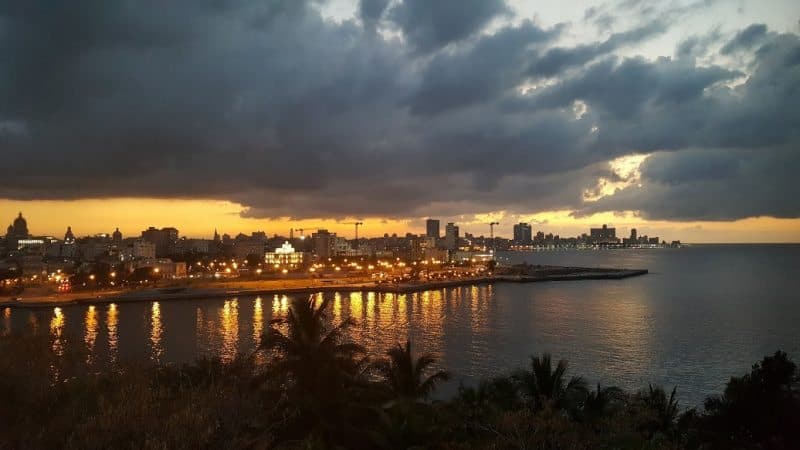
Vinales to Trinidad Cuba on a $720 Budget… It Can Be Done!
By Donal O’Conghaile
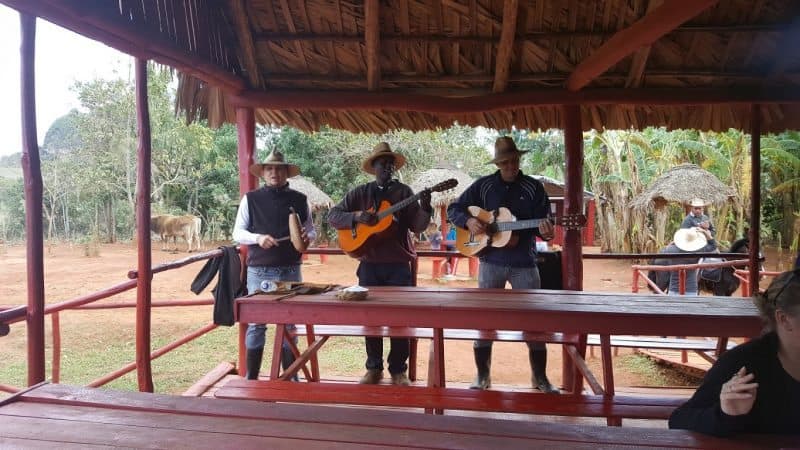
For the first time in many of our lifetimes, travel restrictions between the U.S. and Cuba are being lifted.
It’s not as good as it was when Obama loosened everything, but Cuba is still a viable travel option for something different in the Caribbean.
Today there are more rules, read a story about traveling to Cuba in 2019.
Frozen in Time
It’s true what they say about Cuba – the island really is frozen in time.

You can see it in the architecture, the classic cars and the openness of people whose social skills have yet to be obliterated by modern technology.
Life is extremely bare here compared to what we’re used to in the capitalist world. Grocery store shelves are barren, restaurants are few and far between, services are scarce and transport is a pain in the butt (literally, those Chevy and Buick seats are not kind to the cheeks on long journeys.)
Having said all that, I’ve loved getting to know one of the world’s last remaining socialist nations. The scenery is beautiful, the history fascinating and the people are hands-down the friendliest I’ve ever encountered.
Now is the time to visit Cuba, before the arrival of U.S. tourist dollars that will undoubtedly lead to a new era of Cuban prosperity and degradation of Cuba’s austere charm.
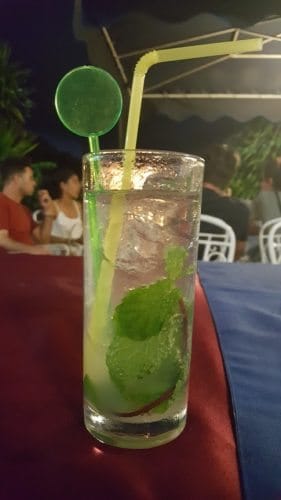
Two weeks for $720US
To the more frugally-minded traveler, Cuba’s state-controlled tourism industry can be a surprising drain on the wallet. Thankfully, with the right combination of information, open-mindedness, and patience, your trip to Cuba can be done on the cheap. I brought $720 in cash for a two-week stay — here’s how I made it last.
The first order of business upon landing in Havana is to get local currency so you can, you know…pay for stuff. I took my cash to exchange for Cuban Convertible Pesos (known as CUC) at the currency exchange (“cambio”) in Havana’s José Marti airport.
Euros or British pounds are the best options to bring because Cuba will tack on a hefty fee to exchange U.S. dollars. The advantage of having all the cash you need upfront is that you won’t have to stand in the insanely long lines at banks across Cuba.
Break Big Bills
Cubans really know how to put the ‘queue’ in Cu-ba (I guess that joke works better if you say it, not type it.) Another thing, take every available opportunity to break large notes like the $50 CUC. Many stores and food outlets will not have change for them.
Your next step will be to get a taxi to your accommodation. There are no airport shuttles like in Europe, but it will take all of five seconds after exiting the terminal for you to be propositioned by a taxi driver eager for your business.
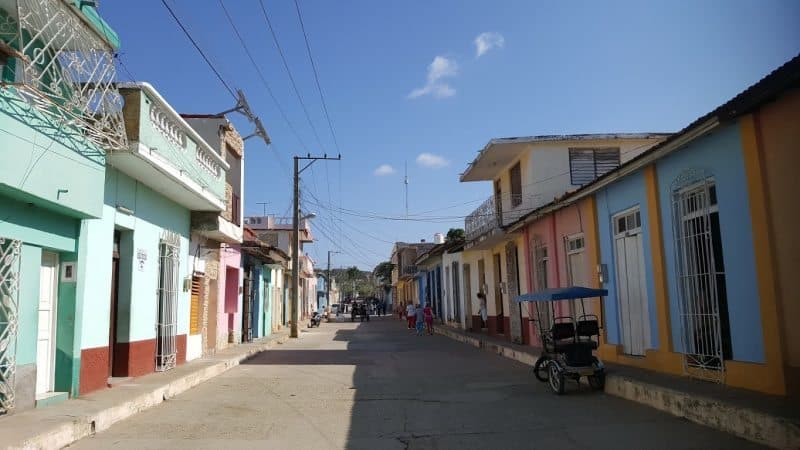
In almost every other city in the world, you’re not supposed to go with these airport hustlers. In Cuba, it’s perfectly ok as they are government-licensed.
Well, almost everything in Cuba is under government control.
Thank you communism. Agree your fare before getting in the car (no more than $25 CUC from the airport to the city center and there is enough competition that you can get it down to $20 CUC) and enjoy the ride.
Accommodations
I booked three nights in the Hamel Hostel in the Centro region of Havana – dirt cheap at just over $5 per night for a bed in a 12-person dorm. This setup is unusual, as you won’t come across many hostels in Cuba.
Everywhere outside of Havana, you’ll be staying in a casa particular, a private family home that rents out an extra room in their house to tourists.

These homestays are pleasant, secure and easy to find. Of course, the whole network is heavily regulated by the government — maybe it’s Castro we should be credited with the original idea for Airbnb?
The downside to staying in a casa is that because the rooms are private, you won’t meet many fellow travelers. The upside is you will get to know the locals! Your casa mama will help you with everything you need: meals, bottled water, advice on what to do in the area, and booking onward transport and accommodation.
Spending Money
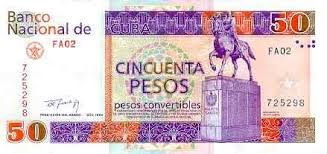
Before I go any further, it’s necessary to explain that Cuba actually has two working currencies. The Cuban Convertible Peso (CUC) is for tourists and equal in value to the U.S. dollar. Then there’s the moneda national, Cuban local pesos (CUP) worth a tiny fraction of what the CUC is worth.
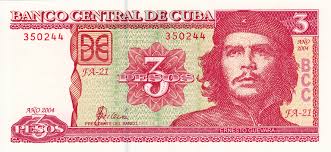
A common scam occurs in stores where you’ll pay for something in CUC and an opportunistic Cuban will give you change back in national pesos.
Always check to make sure you’re holding bills with pictures of monuments on them (CUCs) and not the bills featuring the faces of Cuban heroes (local currency).
It’s perfectly acceptable for you to use the local money where you can. To enjoy Cuba without sucking your wallet dry, seek out local eateries and bars off the tourist track.
A great way to do this is to find the family-run restaurants (paladares) and street eats (like the deliciously cheap ‘peso pizza’) for affordable food payable in Moneda national.
Havana Sightseeing

The ideal place to begin your Havana exploration is by walking along El Malecón, the fortified sea wall that defends the entire city coastline from pirates and Spanish & American invaders. Well, that’s why it was built in the first place and it certainly did its job.
Nowadays, the wall is the place for Cubans to hang out, socialize, engage in PDAs with their loved ones, do a spot of fishing and more. It is a lovely walk, and you can watch the 50s-era Buicks and Chevrolets whiz by dilapidated facades of neglected buildings while you ponder Cuban life.
If you follow the Malecón all the way east you will eventually get to Havana Vieja, the city’s old quarter full of history, beautiful architecture and quirky sights.

To cover a lot of ground quickly, I recommend the ‘four plazas’ walk, wandering from Plaza Vieja to Plaza San Francisco to Plaza des Armas to Plaza de la Catedral. Each square has its own very different charm and there’s plenty to see in between each stop as well. A few highlights:
- Calle Obispo: the main street for souvenirs, bars, restaurants, tourism offices and more.
- The quirky Museo de Naidas, a free museum dedicated to playing cards. See old sets of primitive cards and beautiful designs throughout the ages including my personal favorite: a deck featuring 70s celebrities like Latoya Jackson and George Michael.
- The escuina caliente (literally “hot corner”) is not so much a tangible sight as it is a fascinating aspect of the life of many habaneros. At any time in this one spot in the Parque Central, you’ll find thirty or so Cuban men, vigorously gesturing and loudly shouting. What’s it all about? They’re engaged in a passionate debate about something very important to Cubans… baseball.
- Take the Casablanca ferry ($1 CUC) to view the cannon-firing ceremony that happens every night at the Fortaleza de San Carlos de la Cabaña. If you don’t witness it in person, you’ll likely hear the loud bang no matter where you are in the city. I wish more places had a tradition like this…it’s really exciting to witness.
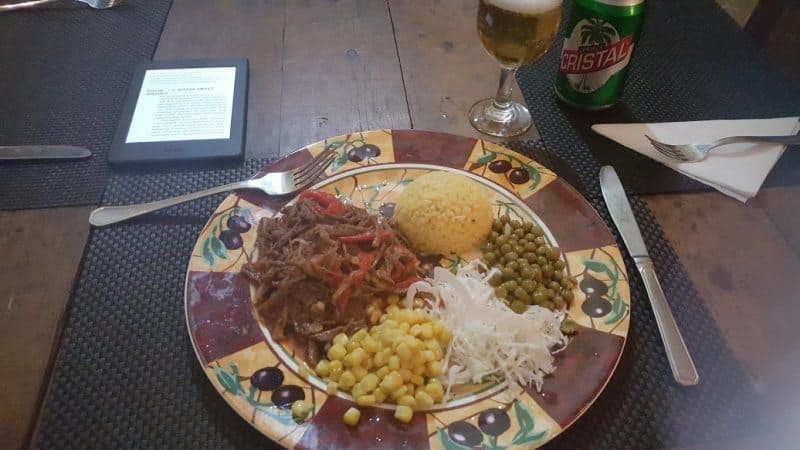
Cuban Food
With a scarce supply of ingredients, little international influence and a general culture of eating for necessity rather than for pleasure, Cuba is not known for its fine cuisine. Some dishes to look out for:
- Ropa vieja (shredded beef with rice cooked with spices and tomatoes)
- Moros y Cristianos (rice and beans)
- Fried plantain chips called chicharitas or mariquitas
- Bistec or pork uruguayo (a beef or pork fillet stuffed with ham and cheese then deep-fried)
- Fish (always caught local and very fresh)
- The aforementioned peso pizza (not exactly Italian but certainly hits the spot)
- Rum, commercialized by Cuban Don Facundo Bacardi. Cuba libres, mojitos and daiquiris are temptingly cheap.
Havana Sightseeing
This time, follow the Malecón west to see the more modern Centro and Vedado neighborhoods. Top picks:
-
- The Museo de la Revolution is a must-visit to get an understanding of how Cuba got to where it is today. Although obviously biased, the exhibition offers a real insight into the battle for independence by Castro, Guevara et al. ‘Patrio o muerte’ is a statement I can’t get to grips with myself, but you’ll marvel at the fearlessness of Cuba’s revolutionaries.
-
- Plaza de la Revolution with its Che Guevara mural and a humongous statue of national hero Jose Marti.
- A very fenced-in American Embassy on the Malecon.
- Hotel Nacional – view the photos of famous guests and stroll the lovely grounds with views over the ocean.
- Lopez Serrano building – an architectural highlight, this structure looks as if someone decapitated the Empire State Building and deposited the head here in Havana.
- Real Fabrica de Tabacos Partagás – all that remains of this cigar factory’s location adjacent to the Capitol building is the shop (worth a visit for the odors alone.) You can now tour the factory at its new location on Calle San Carlos between Situos and Peñalver. Get your ticket in advance at any major hotel.
- Chinatown – I strolled through El Barrio Chino on January 28 which just so happened to be Chinese New Year, yet there was not a single hint of celebration and rarely a Chinese person in sight.
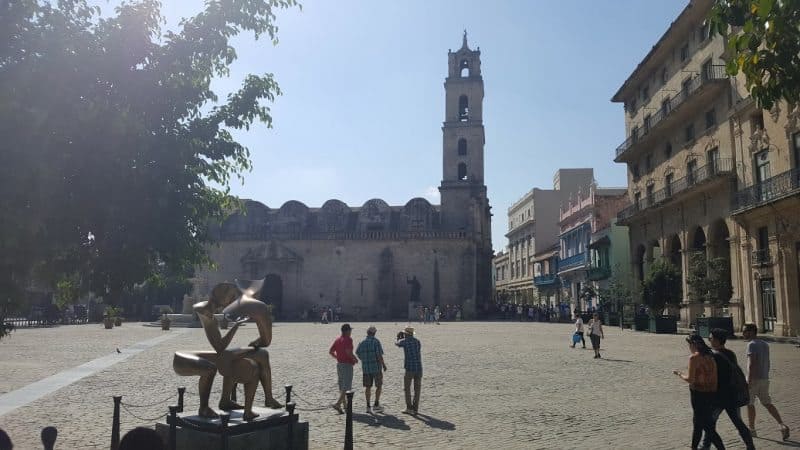
I later chatted with a Taiwanese girl in my hostel who told me that few Chinese people live in Havana’s Chinatown at all. There is a cluster of good “Chinese” restaurants on small and easy-to-miss Calle Cuchillo.
Meeting The Locals
Find a local bar and be open to the friendly Cubans that approach you. On the hunt for a batido (fruit smoothie), I walked down Calle San Rafael from Parque Central. Off the tourist track, there were outlets selling peso pizza and a park with weak WiFi where locals were congregating.
I saw a sign down a side street that read jugos, and found myself in a buzzing local bar. I ordered a mango juice and was immediately approached by a drunk Cuban who mocked me for being Irish and drinking something non-alcoholic.
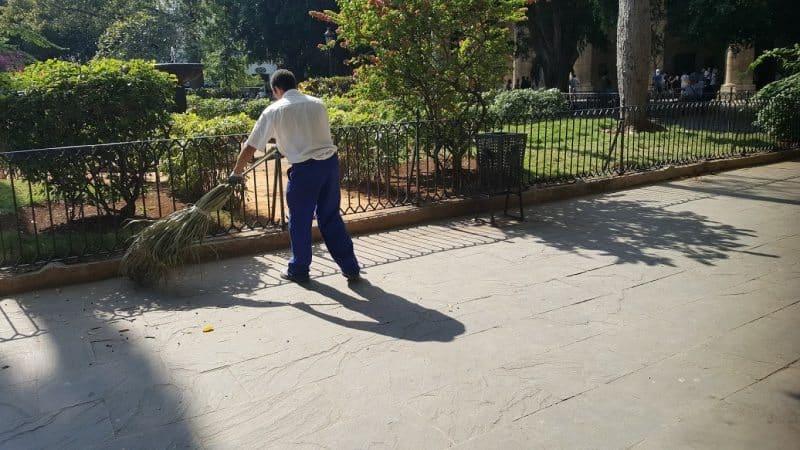
He introduced himself as Fidel Castro, his friends were Vladimir Putin and Barack Obama, and he then proclaimed me to be Donald Trump.
After some bantering in my very limited Spanish, I left feeling quite puzzled but also uplifted after a genuine interaction with some friendly Cubans. Over the course of the next two weeks, I discovered that this was not a once-off.
The nation is positively booming with friendliness. On one occasion, while working out in the park, a habanero started a conversation about how great exercise is, and ended it by inviting me to his house. I think I offended him by not dropping what I was doing and following him home.
Viñales

After two jam-packed days in Havana, I started to tire of the city and made for the countryside of Viñales, the land of tobacco.
The karst valley of Viñales is an absolutely stunning piece of countryside with imposing mogotes – bulbous green hills poking out of the earth.
The valley was formed over millions of years when underground rivers eroded away the limestone causing the rock to collapse inwards, leaving just the mogotes behind.
A stroll through the region is a must. A word of warning: you will be almost convinced that you need a guide to explore the valley.
I was offered as such by my casa owner within ten minutes of arriving. “There are no trails and you’ll get lost!” (There are trails, and I’ll give you directions below.)
“The farmers will forbid you from walking through their lands!” (The lovely farmers were more than willing to point me in the right direction.)
You can head to the Parque Nacional visitors center for information on the area. The office is located two kilometers outside the town on Carretera a Pinar del Rio. However, they will not give you a map and will insist you hire a guide for the day. Fortune favors the brave, so instead, do this:
Take the road called Adela Azcuy north out of Viñales. You’ll know you’re on the right track when you pass the baseball stadium on the left. With the mogotes in front of you, you’ll basically want to circle around them to the right side. At the first major junction, make a right and follow the trails.
Trails might disappear and re-emerge at different points, but as long as you walk with the mogotes always on your left, you’ll make it to the Mural de la Prehistoria, an impressive painting on the cliff face portraying the evolution of man. There’s a lovely cafe along the way where you can get a coffee, cocktail and use the bathroom. Walk back to town the way you came, or more quickly via the main road.
Getting Around Cuba
Getting around Cuba is quite easy as a traveler. Here are your options:
Viazul is the state-run bus service for tourists. Fares are reasonable, routes are plentiful and the rides are pleasant albeit overly air-conditioned (bring a sweater.) It’s a good idea to secure tickets in advance since some of the more popular routes can sell out.
As soon as you know where and when you want to go next, visit the Viazul ticket office located in the bus stations (which are inconveniently situated outside the towns and cities.)
Collectivos are shared taxis, often in classic cars that can get you everywhere Viazul gets you for a similar price, with the added bonus of picking you up at your casa and dropping you off at the door of your new casa.
You’ll be crammed in with other travelers which is not so comfortable but a great way to make new friends. A word of warning, the interior looks vintage and cool but those seats are not kind to the tush. Bring a cushion for any journey over two hours.
Trains. Don’t even go there. The Cuban railroad is slow, confusing and never on time.
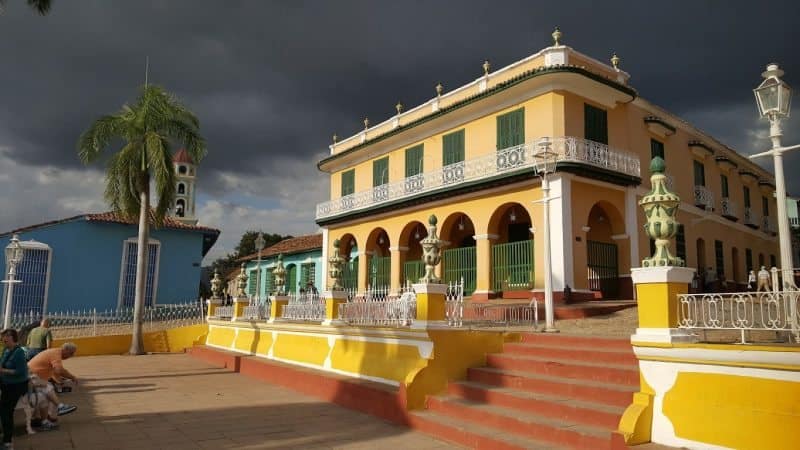
Trinidad
Trinidad, a town that seems to be stuck in the early 1900s and so small you can get your bearings of the entire center in 20 minutes. If you take a day to explore the town, be sure to take your time.
Grab a coffee in the Dulcinea on Marti street. Sitting in a pleasant backyard will help you while away an hour. Meander down side streets of the casco histórico in the loose direction towards Plaza Mayor, when hopefully it’s an acceptable time for lunch when you arrive. Take your time here too, maybe read a book, because you really will quickly run out of sights to see.
In the afternoon, work off that Cuban lunch with a hike up to a viewpoint of the city on Cerro de la Vigía. To get there, walk on Calle Simon Bolivar away from the Plaza Mayor, through a part of town that hasn’t had the cosmetic makeover of the main center (I’m talking dirt roads, dilapidated buildings and the like) and up the hill for a good workout.
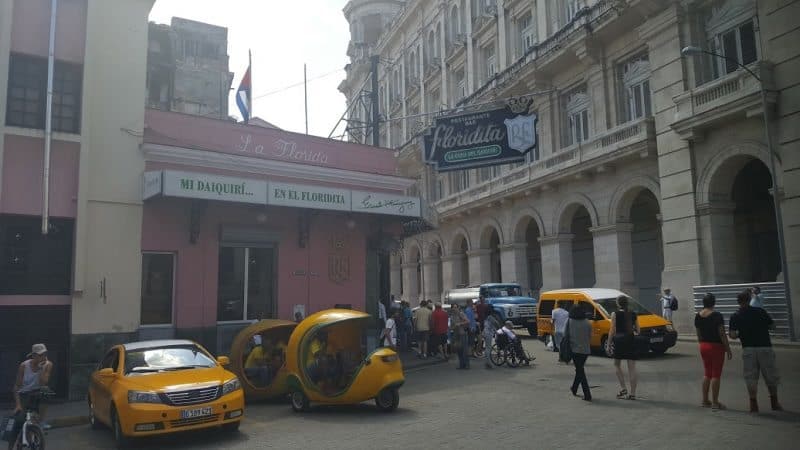
You’ll also pass Disco Ayala, a popular disco located inside a cave. That night, grab a few rum-based cocktails and get ready to head to the beach in the morning.
An off-putting aspect of Trinidad is the street hustlers, at their worst here in this otherwise colonial gem. After a stay here, you’ll almost begin to think your name is ‘taxi’ for the number of times it’s shouted at you on the street.
Don’t give in to the taxi offers and instead rent a bike for the day for $6 CUC from a place on Calle Maceo opposite the post office.
You can ride out to Playa Ancón via the small seaside village La Boca and spend the day relaxing on the peaceful southern shores of Cuba.
Tourist Touts
If you look anything like I do, you’re not going to pass for Cuban no matter how much you think you’ve tanned. Cubans can smell tourists from a mile away, and they know you’ve got money to burn. Be prepared to be inundated with unsolicited offers for taxis, tours, casas, meals, cigars and even an offer from a ‘jintera’.
Yes, there is an active sex trade in Cuba – one of the few activities the government hasn’t been able to stamp out. (Being gay, I got quite a kick out her thinking that I was a potential client!)

Santa Clara
Ahhh, Santa Clara… a place completely devoid of the beauty, charm, architecture, and liveliness of other Cuban towns. So why come here? Well, it’s a convenient stop on the way back to Havana from the eastern and southern parts of the island.
Also, for fans of El Che, Santa Clara is an essential pilg
rimage to learn about the Latin American liberator. Here lies his remains, underneath an impressive monument and a museum that’s closed on weekends.
I discovered this when I walked the two kilometers from the town center to get to the site, and because I couldn’t bear to wait around Santa Clara until Monday, I never saw it.
Otherwise, in Santa Clara, you have a cigar factory with more favorable reviews that of the one in Havana, though it’s also closed on weekends.
If you do find yourself stuck in Santa Clara on a Saturday, swing by Club Mejunje for a lively show and even livelier Cubans.
Cuban People
Cubans are truly helpful, friendly and a joy to get to know. Even with my terribly broken Spanish and their non-existent English, I was able to have many meaningful interactions. Just ignore the awkwardness that comes with a language barrier and throw yourself headfirst into every conversation.
You’ll get what you’re looking for eventually. The title of ‘friendliest people’ is thrown around a lot, but Cubans really are in a whole other class of their own. Being a small island nation with a welcoming, funny and generous populous, Cuba may be the Ireland of Latin America.
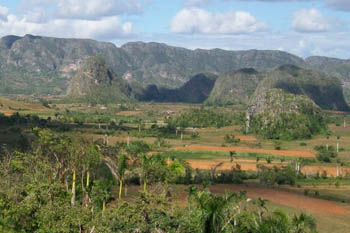
Onward Trips
I’ve covered the main highlights of places to visit in Cuba. From here, you have a number of options depending on your time and interests:
- Cienfuegos: a charming city with French influences.
- Sancti Spiritus: like Trinidad but without the tourist touts.
- Santiago de Cuba: Cuba’s second city, all the way over on the island’s eastern shore.
- Varadero: a relaxing, well-developed and pricey tourist resort. If you’re looking for authentic Cuba, don’t go here.
- Back to Havana: explore areas you may have missed, or take day-trips outside the city to places like Parque Lenin, Playa del Este, and Casablanca.
14-Day Budget Breakdown

All prices in CUC
- Transport: $148
- Accommodations: $255
- Meals & Drinks: $228
- Coffee: $16
- Bottled water: $17
- Toilets: $3
- Attractions: $13
- Souvenirs: $14
- Internet: $6
In total, I spent $700 CUC and had money left over to bring to the currency exchange on my way out of Havana airport.
My budget is simply a guide. You might spend more than me in some categories and less than me in others. Here are some general tips on saving money:
- Skip the appetizers at restaurants as the main portions are large enough to fill you up.
- When dining out, don’t bother ordering water or a soda with your meal. This is a habit we have, but the bottled water in your bag is much cheaper.
- When drinking alcohol, stick to rum cocktails. Cuba’s national spirit is as cheap as water and oh so good.
- If you find yourself paying an entry fee to a museum or attraction simply to pass the time or because everyone says you must go there, don’t bother. See the sights you really want to see and remember, the best activity is often to simply walk around and get a feel for a place.
- In Cuba, there’s always room for negotiation. See if you can get a lower price on two of your biggest expenses: transport and accommodation. Souvenirs too.
- Set menus at restaurants are not often advertised to tourists but it’s perfectly acceptable to ask. You’ll often get the main course, soup or salad, dessert and drink for around $5 CUC.
- Eat your largest meal of the day at lunch, which is most of the time the same food as dinner at a lower cost.
- This may not be for you, but I personally skipped breakfast except for coffee. However, breakfast at your casa will be cheap and plentiful (eggs, fruit, bread, etc.)
- Eat at the street side food providers where priced in the local currency, the menu items cost a pittance. I tried these places a few times but didn’t depend on them as there’s not much concern for nutrition (mostly pizzas, measly ham and cheese sandwiches and rarely a vegetable in sight.)
- Resist the urge to take taxis and bike-taxis within a city. The urban centers of Cuba are small and very walkable, though the taxi touts will tell you otherwise.

Donal O’Conghaile is a writer and online community manager from Ireland, living in New York City. He’s currently traveling around Latin America for six months. Keep up with his adventures on Twitter at @Donal_IRL.
- Shhh, Keep Quiet About Queretaro - September 30, 2024
- Wroclaw Poland: A City Full of Dwarfs - September 25, 2024
- Hoi An–A City Frozen in Time - September 19, 2024



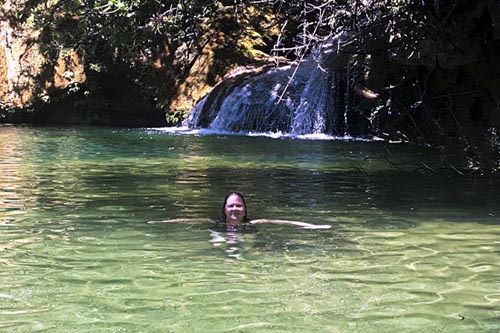

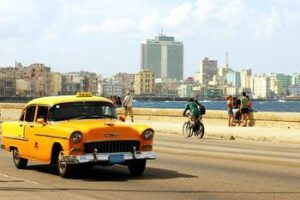
Hi 🙂
Good post!
My wife and I are considering going to Cuba for two weeks and visiting Vinales and Trinidad is a must 🙂
We have researched on the Internet and we already have an idea of how much we are going to spend and the truth is that it does not seem so expensive, in terms of accommodation and food, but what does seem expensive is transportation 🙁 We have found out and the bus from Havana to Vinales costs only $ 10 USD 🙂 but the tour lasts about 4 hours which is a long time, on the other hand, collective taxis … mmmhhh we have seen videos on youtube and they really seem very uncomfortable. We prefer to pay a taxi or a private tour, although the initial idea is to spend 3 days in Vinales to get to know it thoroughly, we can adjust our itinerary.
After a thorough investigation we have found a tour and transfer provider that seems quite professional and with reasonable prices:
https://www.havana60.com/havana-to-vinales-taxi/
I wonder if you have ever used it or have you heard of them? Do you have any recommendations you can offer us?
Many thanks,
John